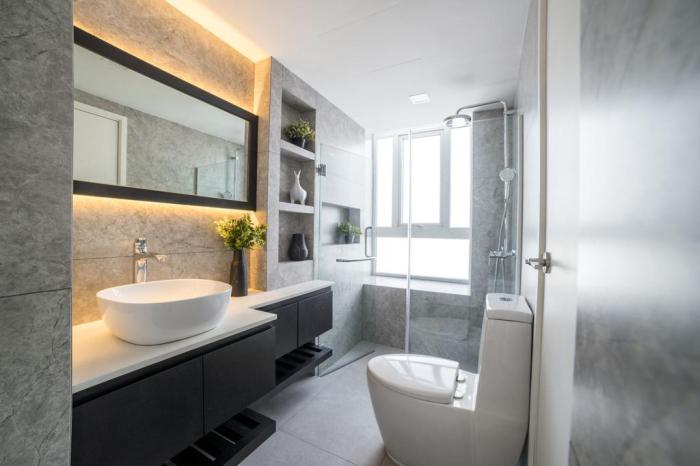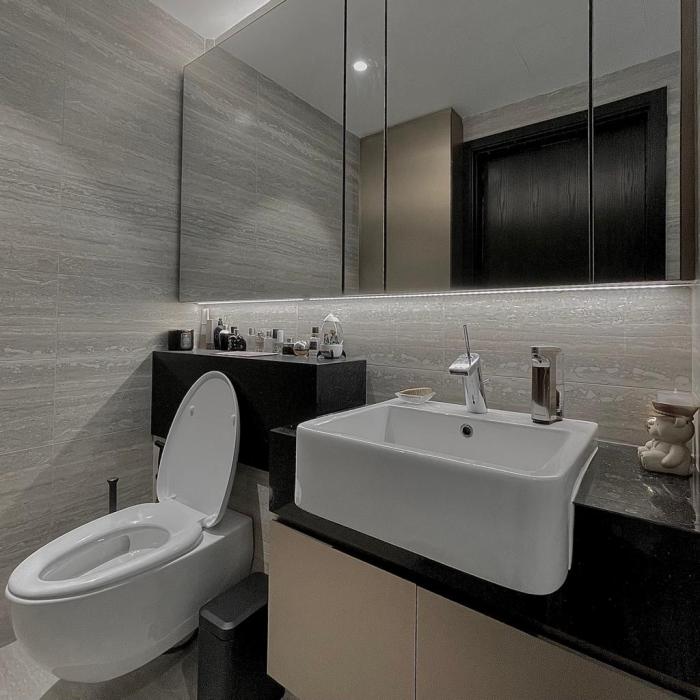Elevating Your Space: Bathroom Interior Design Tips

Embark on a journey through the world of bathroom interior design, where functionality meets aesthetics in perfect harmony. From essential elements to current trends, this guide has everything you need to transform your bathroom into a stylish oasis.
Discover the secrets to creating a space that not only adds value to your home but also reflects your personal style and preferences.
Importance of Bathroom Interior Design
When it comes to designing a home, the bathroom is often overlooked, but it plays a significant role in the overall functionality and aesthetics of a living space. A well-designed bathroom not only enhances the comfort and convenience of daily routines but also adds value to the property.
Enhancing Home Value
A thoughtfully designed bathroom can significantly increase the resale value of a home. Features such as modern fixtures, quality materials, and a cohesive design scheme can attract potential buyers and set your property apart in a competitive real estate market.
Impact of Lighting, Color Schemes, and Layout
- Proper lighting is crucial in a bathroom to ensure visibility for grooming tasks and create a welcoming ambiance. Incorporating natural light, task lighting, and ambient lighting can transform the space.
- Choosing the right color schemes can affect the perceived size and mood of a bathroom. Lighter colors can make a small space feel larger, while bold colors can add personality and drama to the design.
- The layout of a bathroom should be functional and efficient, considering the placement of fixtures, storage options, and traffic flow. A well-planned layout can optimize space and improve the overall user experience.
Elements of Bathroom Interior Design
When it comes to designing a bathroom, there are several key elements that play a crucial role in creating a functional and visually appealing space.
Fixtures and Fittings
Fixtures and fittings such as faucets, showerheads, and toilets are essential components of any bathroom design. These elements not only serve a practical purpose but also contribute to the overall aesthetic of the space.
- High-quality fixtures can enhance the look and feel of a bathroom, adding a touch of luxury.
- Choosing fixtures in complementary finishes can help tie the design elements together for a cohesive look.
- Opting for water-efficient fixtures can also help reduce water consumption and lower utility bills.
Materials
The materials used in a bathroom can make a significant impact on its design and functionality. From tiles to countertops, selecting the right materials is essential for creating a durable and stylish space.
- Water-resistant materials like porcelain tiles or quartz countertops are ideal for bathrooms to withstand moisture and humidity.
- Natural materials such as marble or wood can add warmth and texture to the design, creating a spa-like atmosphere.
- Choosing easy-to-clean materials can also make maintenance a breeze, ensuring your bathroom stays looking its best for years to come.
Storage Solutions and Organization
Effective storage solutions and organization are key aspects of bathroom design to keep the space clutter-free and functional. From built-in cabinets to floating shelves, there are various options to maximize storage in a bathroom.
- Utilizing vertical space with tall cabinets or shelving units can optimize storage without taking up valuable floor space.
- Incorporating organizers like drawer dividers and baskets can help keep toiletries and essentials neatly arranged and easily accessible.
- Customizing storage solutions to fit your specific needs can ensure a well-organized and efficient bathroom layout.
Mirrors, Vanities, and Accessories
Mirrors, vanities, and accessories play a significant role in enhancing the design of a bathroom while also serving practical functions. These elements can add style, depth, and functionality to the space.
- Strategically placing mirrors can reflect light and create the illusion of a larger, brighter space.
- Choosing a vanity that complements the overall design can tie the room together and provide essential storage for daily essentials.
- Adding accessories like towel racks, soap dispensers, and plants can inject personality and style into the design, making the bathroom feel more inviting and personalized.
Trends in Bathroom Interior Design

In the ever-evolving world of interior design, trends in bathroom design continue to shift and adapt to the needs and preferences of homeowners. From minimalist designs to nature-inspired elements, and even the integration of smart technology, there are various trends shaping the modern bathroom aesthetic.
Minimalism and Clean Lines
- Minimalist designs with clean lines and clutter-free spaces are gaining popularity in bathroom interiors.
- Simple color palettes, sleek fixtures, and efficient storage solutions are key elements of minimalist bathroom design.
- Open shelving, wall-mounted vanities, and hidden storage options contribute to the overall minimalist look.
Nature-Inspired Elements
- Nature-inspired elements such as natural stone, wood accents, and indoor plants are being incorporated into bathroom designs to create a calming and organic atmosphere.
- Earthy tones, textured materials, and biophilic design principles are used to bring the outdoors inside and promote relaxation.
- Bathrooms with large windows, skylights, or indoor gardens are becoming more popular to enhance the connection with nature.
Smart Technology Integration
- Smart technology is revolutionizing bathroom design with features like sensor-activated faucets, smart mirrors, and temperature-controlled showers.
- Voice-activated assistants, waterproof speakers, and smart lighting systems are also being integrated into modern bathrooms for added convenience and luxury.
- Smart toilets with bidet functions, heated seats, and self-cleaning capabilities are becoming increasingly popular for their advanced features and hygiene benefits.
Color Schemes and Themes

When it comes to bathroom interior design, color schemes and themes play a crucial role in setting the ambiance and overall feel of the space. Whether you prefer soothing neutrals, bold accents, or monochromatic palettes, the right colors and themes can transform your bathroom into a relaxing retreat or a stylish sanctuary.
Color Schemes
- Neutrals: Shades of white, beige, and gray are timeless choices that create a clean and serene atmosphere in the bathroom.
- Bold Accents: Adding pops of vibrant colors like teal, navy blue, or emerald green can inject personality and energy into the space.
- Monochromatic Palettes: Opting for varying shades of a single color, such as different tones of blue or green, can create a cohesive and harmonious look.
Themes
- Spa-Inspired: Incorporating natural elements, such as wood, stone, and plants, can evoke a spa-like feel in your bathroom, promoting relaxation and tranquility.
- Vintage: Choosing retro fixtures, clawfoot tubs, and ornate mirrors can transport your bathroom back in time, adding charm and character.
- Contemporary: Embracing sleek lines, minimalist design, and modern finishes can give your bathroom a fresh and sophisticated look.
Tips for Selection
- Consider the size and layout of your bathroom when choosing colors and themes. Lighter shades can make a small bathroom feel more spacious, while dark colors can add drama to a large bathroom.
- Think about the mood you want to create in the space. Soft pastels can create a calming vibe, while bold hues can make a statement.
- Experiment with different color combinations and themes to find what resonates with your personal style and complements the existing decor in your home.
Sustainable and Eco-Friendly Design
When it comes to bathroom interior design, incorporating sustainable and eco-friendly practices is becoming increasingly important. Not only does it help reduce our carbon footprint, but it also promotes a healthier living environment.
Water-Saving Fixtures and Eco-Friendly Materials
Incorporating water-saving fixtures such as low-flow toilets and faucets can significantly reduce water consumption in the bathroom. Likewise, using eco-friendly materials like bamboo, recycled glass, or reclaimed wood not only adds a natural touch to the space but also minimizes the impact on the environment.
Opting for low VOC paints can also improve indoor air quality, making the bathroom a safer and healthier space.
Tips for Creating an Eco-Friendly Bathroom
- Choose energy-efficient lighting options such as LED bulbs to reduce electricity consumption.
- Install a dual-flush toilet to conserve water and reduce wastage.
- Use natural or organic bath products to limit exposure to harmful chemicals.
- Consider adding plants to the bathroom to improve air quality and add a touch of nature.
- Opt for sustainable flooring options like bamboo or cork that are durable and environmentally friendly.
Ultimate Conclusion
As you delve into the realm of bathroom interior design, remember that every detail counts in crafting a space that is both beautiful and practical. Implement these tips and watch as your bathroom transforms into a luxurious retreat that you'll never want to leave.
FAQ Compilation
How important is lighting in bathroom design?
Lighting is crucial in creating the right ambiance and functionality in a bathroom. Proper lighting can enhance the overall look and feel of the space.
What are some popular materials for modern bathrooms?
Materials like marble, brass, and matte black finishes are currently trending in modern bathroom design for their sleek and stylish appeal.
How can I make my bathroom more eco-friendly?
You can incorporate sustainable practices by using water-saving fixtures, eco-friendly materials like bamboo, and low VOC paints to create an eco-friendly bathroom without sacrificing style.

